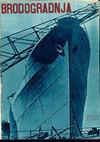矩形截面浮力曲线中心及其渐线的重新检验,第2部分:使用二次函数
IF 4.2
4区 工程技术
Q1 ENGINEERING, MARINE
引用次数: 0
摘要
本文用二次函数给出了矩形截面浮力中心曲线和稳心轨迹曲线的精确静水细节方程。到目前为止,这些方程还没有针对跟角的双曲线范围给出,这里它是通过使用基本的二次函数及其水平对称的浸入形状来完成的,并定义了两种新方法:1。基本横截面形状的旋转,以及2。静水截面面积互补法,该法使用矩形截面的露出和浸入区域的同质性或比例特性。观察到的矩形稳心曲线由具有2/3指数和负号的半三次抛物线和Lamé曲线组成,导致这些函数定义的对称性存在尖点不连续性。为了实现这一点,给出了两个定理:利用静水截面面积补标的定理和浮力切线中心与水线平行的定理。本文在第一部分给出了矩形截面稳心曲线燕尾不连续性存在的无量纲界后,在第二部分给出了它在矩形顶角对称性中的位置证明,从而从理论上证实了它的位置。本文章由计算机程序翻译,如有差异,请以英文原文为准。
Re-examination of centre of buoyancy curve and its evolute for rectangular cross section, Part 2: Using quadratic functions
In this paper, exact hydrostatic particulars equations for the centre of buoyancy curve and metacentric locus curve are given for rectangular cross section using quadratic functions. Those equations have not been given for the hyperbola range of the heel angles so far, and here it is done by using basic quadratic functions and their horizontally symmetric immersion shapes, with two new methods defined: 1. Rotation of basic cross section shapes, and 2. Hydrostatic cross section area complement method that uses homothety or scaling properties of emerged and immersed areas of the rectangular cross section. Observed metacentric curve for rectangle consists of semi-cubic parabolas and Lamé curve with 2/3 exponent and negative sign, resulting in the cusp discontinuities in the symmetry of those functions definition. In order to achieve above, two theorems are given: the theorem about scaling using hydrostatic cross section area complement and the theorem about parallelism of centre of buoyancy tangents with waterlines. After non-dimensional bounds are given for the existence of the swallowtail discontinuity of metacentric curve for rectangular cross section in the Part 1 of this paper, the proof of its position in the symmetry of rectangle vertex angle is given in this Part 2 of the paper, thus confirming its position from theory.
求助全文
通过发布文献求助,成功后即可免费获取论文全文。
去求助
来源期刊

Brodogradnja
ENGINEERING, MARINE-
CiteScore
4.30
自引率
38.90%
发文量
33
审稿时长
>12 weeks
期刊介绍:
The journal is devoted to multidisciplinary researches in the fields of theoretical and experimental naval architecture and oceanology as well as to challenging problems in shipbuilding as well shipping, offshore and related shipbuilding industries worldwide. The aim of the journal is to integrate technical interests in shipbuilding, ocean engineering, sea and ocean shipping, inland navigation and intermodal transportation as well as environmental issues, overall safety, objects for wind, marine and hydrokinetic renewable energy production and sustainable transportation development at seas, oceans and inland waterways in relations to shipbuilding and naval architecture. The journal focuses on hydrodynamics, structures, reliability, materials, construction, design, optimization, production engineering, building and organization of building, project management, repair and maintenance planning, information systems in shipyards, quality assurance as well as outfitting, powering, autonomous marine vehicles, power plants and equipment onboard. Brodogradnja publishes original scientific papers, review papers, preliminary communications and important professional papers relevant in engineering and technology.
 求助内容:
求助内容: 应助结果提醒方式:
应助结果提醒方式:


